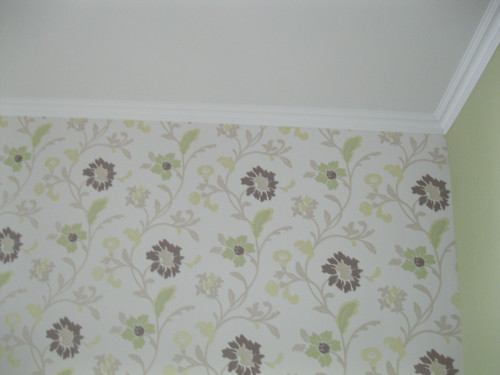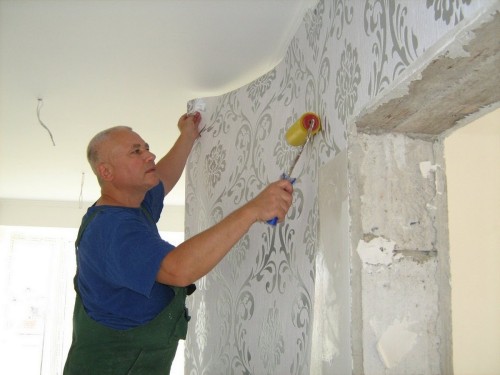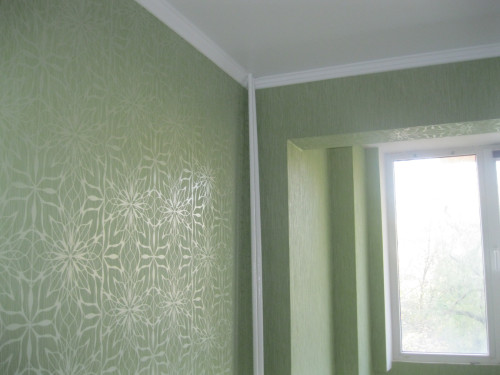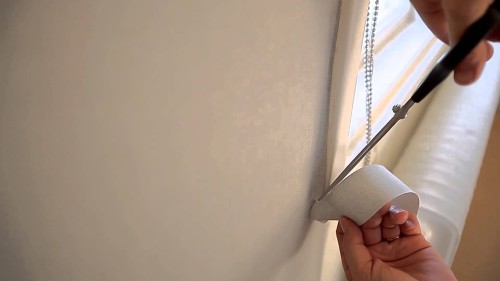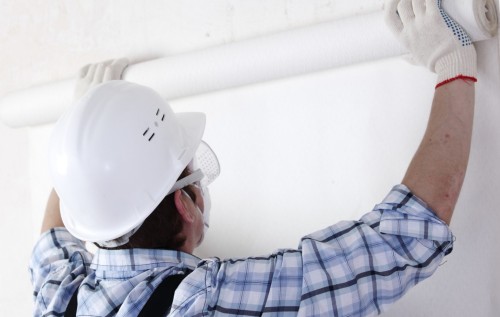Wallpaper sticking is a fairly simple process that forces to each person. To date, you can find a huge range of this product on sale, and every year there are completely new solutions on the market - improved wallpapers that are able to create even from the most inconspicuous housing are a cozy space.
Content
It is safe to say that to create an attractive interior there are enough two details: choose the most suitable wallpapers, as well as to make their adhesion as much as possible. It is worth saying that it is the first part for many people who turn out to be the most difficult, since the range of colors and textures that is available on sale is simply impressive. Hundreds of wallpaper options are not always the positive news for the owners, since because of the abundance of choice, you can make not the most successful choice. Thus, it should be presented in advance which walls it will be better to look at a particular room. Perhaps paper material must be combined with other housing elements. This question may include many diverse aspects, so talk about what.
Immediately the process of gluing wallpaper itself is simple, but one thing to do this business is not the best option, since many parts of the process are designed for two or more people. It is worth understanding that this is reflected in the repairs time.
It becomes clear that in the process of blending wallpaper there are many details that should be analyzed, and then to accept some solutions.
In this article we will talk about the process of glue of wallpaper, as well as analyze the specifics of the choice of wallpaper, which material most successfully looked in a particular space. Guided by our recommendations, you can easily implement a successful space of space.
Features of the choice of wallpaper
To begin with, I would like to note that the choice of wallpaper is the most advantage that should be used in any conditions. As we said, the wallpaper allows you to make almost any space attractive, and often you just need to analyze the situation and choose the most optimal material. By the way, not all of the wallpaper at first glance turns out to be the best choice. It happens on the contrary, when first products look perfect, but in fact it does not combine with anything, and also does not constitute anything good for the dwelling design. To make the most faithful choice, you must imagine how the wallpaper will look at a particular home. You can pay attention to the examples of the interior, which are often present on packaging with wallpaper.
There are quite a lot of wallpaper options that are manufactured by various companies. Accordingly, on the Internet, you can easily find examples of interiors in which this product is applied. This will make the most correct choice, as well as know in advance what should be expected in the end.
It should also be paid to the following types of wallpaper:
- Paper. Of course, this is the easiest, optimal, reliable and cheap option that still continues to be in the leaders among the inhabitants of the CIS. Paper wallpapers are relatively inexpensive, many people can afford them, and at the same time, if necessary, they can be changed to new ones. Of course, these wallpapers have significant disadvantages, and often they are associated with low moisture resistance. In addition, often the image on such wallpapers will be burned out, so residential space should be assessed, and only after that purchase paper wallpapers.
- Vinyl. These are also common wallpapers that have gained popularity relatively recently. They consist of a layer of paper, fabric, as well as PVC films. The last layer is located on top, so it provides a certain reliability of the coating. Accordingly, such wallpaper is extremely attractive drawings and textures on the surface. These same images do not fade under sunlight, so the wallpapers remain attractive outward for a long time. It is known that such wallpapers are not toxic, as well as easily oppose the action of fungus. It is also noted that the vinyl product is easily located on irregularities, and in some situations they hide these the most disadvantages that often appear on concrete surfaces. Many people who extremely negatively belong to the disadvantages of paper wallpapers, choose vinyl coatings. Accordingly, these wallpapers are not afraid of either high humidity nor dirt on the surface.
- Gymelomes. This is a fairly specific product that still has gained some popularity in the market. It is important to note that such wallpapers are made on the basis of tissue or yarn, which is made on the basis of thin threads drawn from glass. These threads are obtained by using high temperatures. It is worth noting that these are practically universal wallpaper, and they are able to last up to 30 years.
- Textile. These wallpapers consist of a paper base to which an artificial or natural textile canvas is attached. Often this products are created on the basis of silk, flax or viscose. Good news is that such products create various designers, so there is always the opportunity to make your home original. When creating textile wallpapers, you can use a wide variety of threads and colors. Accordingly, freedom of action is present here. To date, there is a colossal number of equipment, with which you can create textile coatings without any particular problems, while applying a variety of drawings, as well as patterns and other decorative elements. The weak side of the textile wallpaper is that the surface of this product is actively engaged, so they can be unusually quickly.
- Liquid. Such material is made on the basis of cellulose or cotton fibers. In addition, various dyes and adhesive composition are used. In certain situations, some other components are added to the composition, among which dry algae, bark and mica. Most often, such wallpapers are offered by producers in the form of dry mixtures, and in such a form to name their full-fledged wallpaper, the language does not turn. Many people attract the fact that liquid wallpapers have a microporous structure, which makes the surface really attractive outwardly. In addition, the surface becomes soft, and on the touch such a coating is pleasant. The strength of liquid wallpapers is the fact that the coating easily fills all the cracks in places where platbands, frame and plinth are adjacent to the walls. In some cases, these wallpapers are highly hidden by cracks, as well as some other defects that often take place on the walls. This allows not to carry out mandatory repair, which is usually required if it is decided to apply other types of wallpaper. Liquid wallpapers will dry up to 72 hours. Such inconveniences are not satisfied with many tenants, therefore it is worth paying attention to it.
- Fliseline. These wallpaper differ from the usual in that instead of paper there is a fliseline base. This resource is a combination of material into which cellulose and fibers are included. The strength of the flieslinic wallpaper is the total strength, which is significantly higher than the usual paper wallpaper. The process of adhesive such wallpapers is also much easier than in the case of ordinary wallpaper. It is worth understanding that when wetting fliesline wallpaper will not be deformed, which is definitely good if it comes to housing with high humidity. When sticking such a material, glue is applied solely on the wall. It is worth remembering about this feature.
Specificity of shoes wallpaper
After we decided on the wallpaper, they chose the best kind of material and its coloring, should be switched directly to the repair process. It should be borne in mind that these events are often divided into several stages, each of which has tremendous importance. I would like to note in advance that the situation associated with the blending of wallpaper is often specific, and it all depends on the specific space and existing conditions. Therefore, additional consultation with specialists will definitely be superfluous.
- First of all, wall preparation is carried out. Obviously, there are coatings on each surface, which before sticking wallpaper should be lost. This, for example, old wallpaper, or another finishing material. It should be done so that the wall is "bare". We must not spare with all the available layers and start creating a beautiful surface with new wallpaper. Do not forget that irregularities and other flaws are often present on the surface, which may be too serious a problem for repair. Accordingly, first of all, the wall alignment, plaster and primer should be carried out. In some situations, the mills may have too deplorable. With such a situation, you need to do everything possible so that on the future coverage of wallpaper it does not affect. For example, you can equip a drywall surface, or use the cement mixture to be filled with emptiness. It is necessary to understand that sooner or later all the shortcomings of the wall should be corrected, but it is better to do it earlier until the wall has not fully in disrepair. Also before the process of sticking wallpaper, you need to remove all the garbage from the room.
- Further, we are talking about the correct wall markup so that the process of gluing the wallpaper passed as high quality. For this case, it is often used long plumb, as well as chalk, which creates marking. This will be a landmark that allows you to stick the wallpaper exactly where the material should be. Surely, many know that the owners often spend this process "on the eye", and the result is quite good. Often this is the owners who have experience in their back, allowing to carry out this kind of repair work without unnecessary devices and wisdom technologies. Already after putting the first sheet of paper material, it is possible to continue without prior markup. Often the process occurs quickly and efficiently.
- Each wallpaper line should have a certain size. You can produce all the necessary measurements in advance and cut the necessary parts, but it is necessary to remember that it is necessary to add 2 cm to the required length. This is necessary in order to be able to align the irregularities at the floor level. Do not forget that under different conditions, the wallpaper can be slightly stretched and narrowed, so the same size of the sheet of wallpaper will be extremely useful.
- Now the time comes to carry out glue inside out of wallpaper. It is important to draw attention to the fact that in some cases it is advisable to apply adhesive precisely on the wall, as this will ensure maximum high-quality clutch. It should be borne in mind that glue should be applied using a roller or brush. The first option is the most optimal, as it ensures the absence of possible spaces on the surface, which may well be when using the brush. Of course, along with this you need to be and as careful as possible, since it is often, while working, you can distract and skip the wallpaper plot, and after a while it will give yourself to know. Most often, some volume of glue is applied to the wallpaper, after which the roller occurs its distribution over the entire surface. It is also important to distribute the glue and on the edges of wallpaper, since it is precisely in these places that problems associated with far from the best clutch with the wall occur.
- After the distribution of glue on the surface of the material, it is possible to add wallpapers with a lubricated surface inside. This is done so that the paper base is better impregnated with glue. Accordingly, this will provide high-quality clutch, even if the glue does not differ too high quality.
It is worth noting the glass windows separately, as well as the flieslinic material. When using this product, the glue is applied solely on the wall, and not on the wallpaper.
As for the features of the walls of the walls, the last years no one uses the method of "Vansel". The thing is that the option "Butt Jack" allows you to get the most attractive surface, especially when it comes to creating an attractive visual composition on the wall surface. In this case, there are often different difficulties, since it is not always possible to make it possible to produce gluing the adhesive. You should do everything possible so that this same thing is minimal, however, and one should not go to another sheets.
- Immediately after gluing the sheet of wallpaper to the wall, you need to arm yourself with a rubber roller (or a special brush) and from top to bottom, as well as from the middle to the edges, carry out surface smoothing. It should be done as high quality as possible, since after sticking, bubbles and other irregularities are definitely formed, from which you need to get rid of as soon as possible. Most often, after applying to the material of a large amount of glue, the wallpaper becomes wet, so the leveling becomes a simple and rapid process.
Wallpaper sticking in the corners
Many people who do not have enough experience in the repair process are often faced with difficulties in sticking wallpaper in the corners.
Most often it makes sense to combine wallpaper sheet, but you need to do so that the sheet does not enter any of the neighboring sides by more than 5 cm.
In addition, in some cases, one sheet of wallpaper is overlapped by others on the same 5 cm. With such a situation, after plating wallpaper, the extra piece is simply cut out. In the end there will be no gap, and the quality of the adhesion of wallpaper will be quite high.
If we are talking about sticking wallpapers within an external angle, then here the hosts are often risking and produce the repair process exactly as in any other place. If the wall surface has no significant flaws, then no problems should be. Obviously, in each individual place in the dwelling should be considered individually.
Purchase rolls for sticking
For many people is a big problem to buy the desired wallpaper volume. Often the home housing produces some calculations that allow you to determine the number of wallpapers for current repairs. Often these very calculations are incorrect, so you should pay attention to the following information.
- First of all, you need to arm a tape measure and note the width of wallpaper on it. Accordingly, with a tape measure move throughout the perimeter of the room, after which we obtain a certain value. It should be borne in mind that you should capture the places of window openings, as there will be a wallpaper too.
- Next, you need to note the distance from the floor to the ceiling. This will determine the length of the so-called wallpapers.
- After that, you need to calculate the number of entire cloths that will completely cover the height of the wall. At the same time, it is necessary to take into account the length of the roll, as well as the presence of a pattern on the material and the size of the necessary fit. Most often, some information associated with length and fit is indicated on the roll. For example, if the pattern is large, then the size of the fitting is up to 60 cm.
- In the end, those areas that do not require whole cloths are measured. After that, it is possible to make a calculation associated with the general necessary label of wallpaper, as well as the number of rolls.


